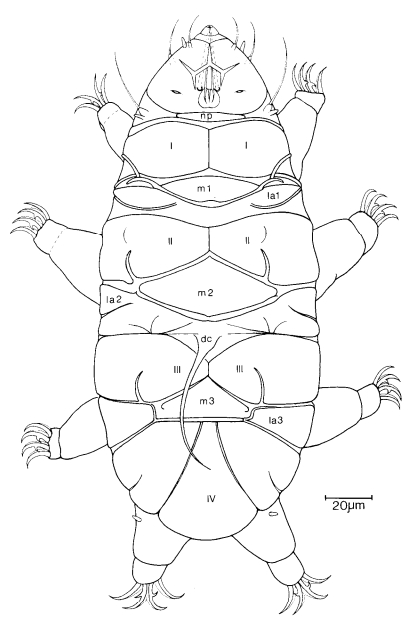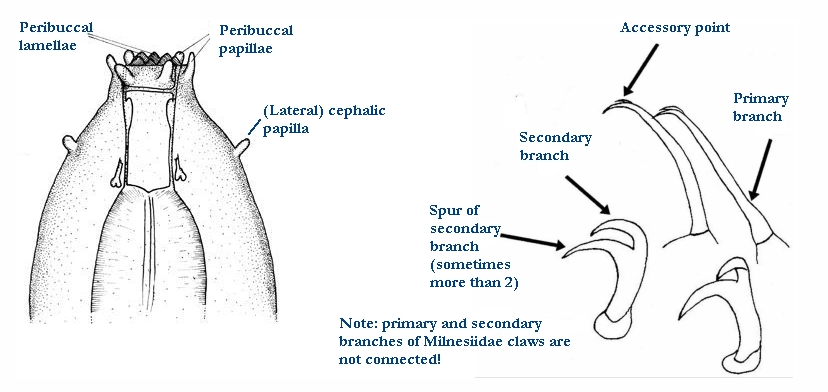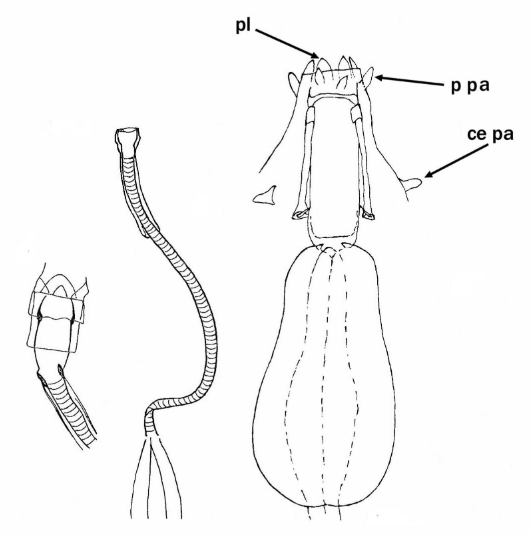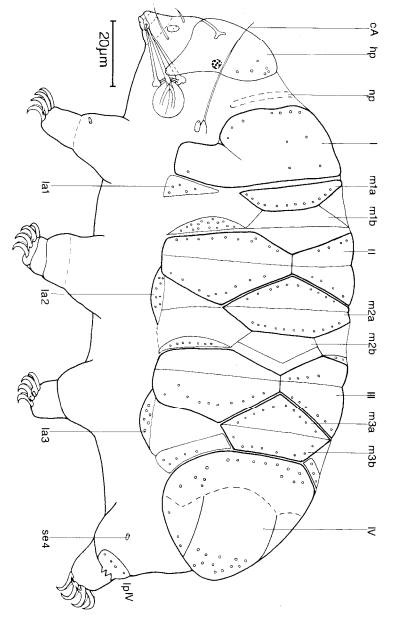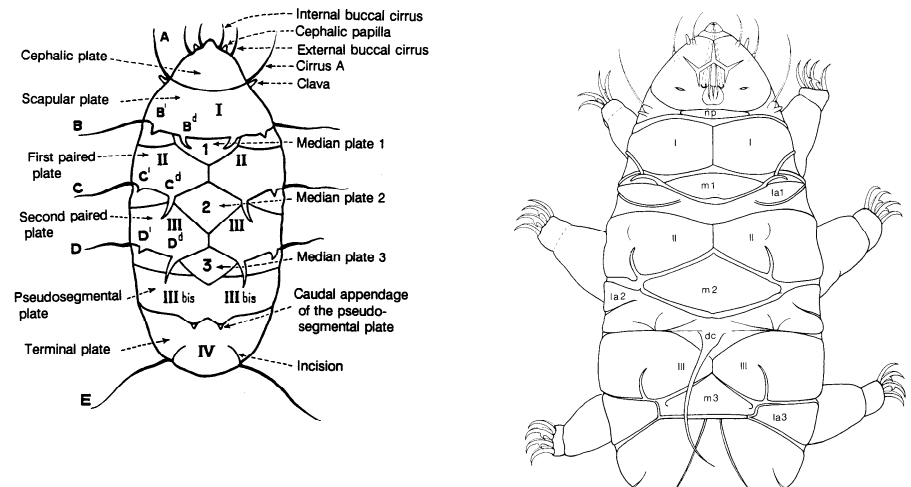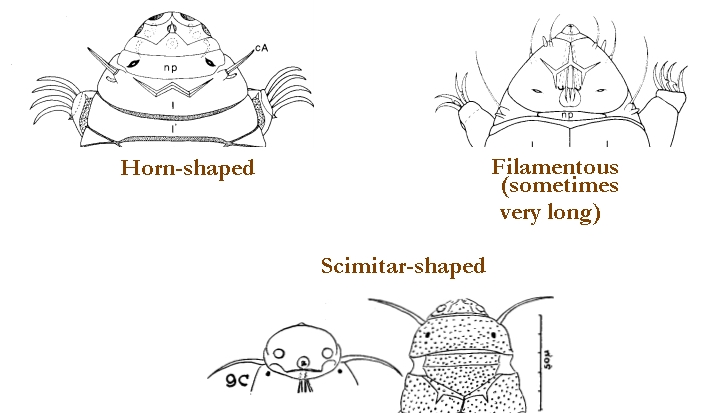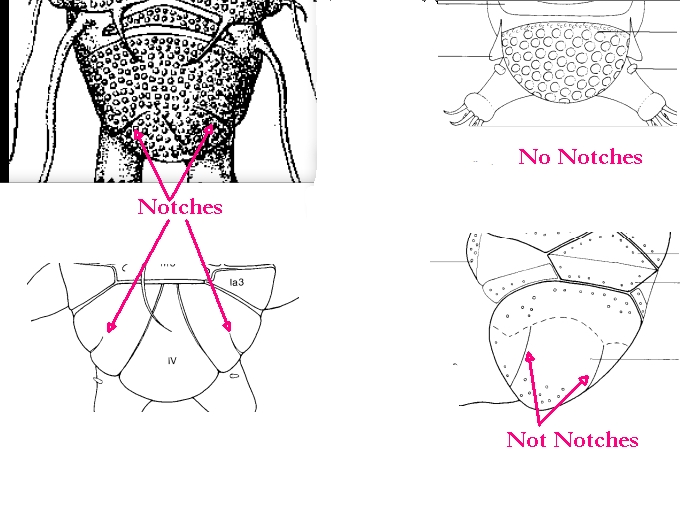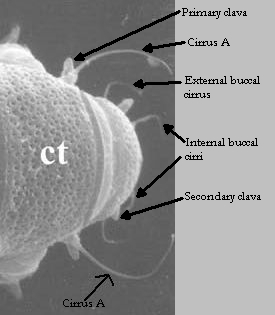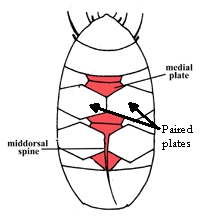From Thulin 1928: “Echiniscidae with armor containing five median plates. End plate adjacent to the last median plate. Terminal notches present. Echiniscus gladiator MURRAY var. exarmatus MURR leads to this genus. The exarmatus form (from the Faroe Islands) that I have examined differs in some aspects from MURRAYS description: The animals are colorless with black eyes. The conjunctiva of the shell shows the same fine granulation as the plates. The end plate is faceted, with two lateral caudal facets and one unusually far reaching; the terminal notches are relatively short and wide. On the former deviations should no great weight be placed. As far as the end plate is concerned, MURRAY’s figure seems to me to say that he did not keep the terminal notches and the edges of the caudal facet apart, and that the latter caused him to regard the plate as being ‘extremely trifoliate’.”
Untranslated: “Echinisciden mit einem Plattenpanzer, der funf freie Schaltplatten enthalt. Endplatte an die letzte Schaltplatte grenzend. Kleeblattkerben vorhanden. Zu dieser Gattung führe ich Echiniscus gladiator MURRAY mit der var. exarmatus MURR. Die von mir untersuchte exarmatus-Form (von den Färöern stammend) weicht in einigen Punkten von MURRAYS Beschreibung ab: Die Tierchen sind farblos mit schwarzen Augen. Die Bindehaut des Panzers zeigt dieselbe feine Granulation wie die Platten. Die Endplatte ist fazettiert, mit zwei lateralen und einer sich ungewöhnlich weit hinauf erstreckenden kaudalen Fazette; die Kleeblattkerben sind verhältnismässig kurz und breit. Auf die ersteren Abweichungen dürfte kein grösseres Gewicht zu legen sein. Was die Endplatte betrifft, scheint mir MURRAYS Figur dafür zu sprechen, dass er die Kleeblattkerben und die Kanten der kaudalen Fazette nicht auseinander gehalten hat und dass die letzteren ihn veranlasst haben, die Platte als besonders ‘deeply trifoliate’ anzusehen.”
From Ramazzotti & Maucci: “There are visible inclusively 5 median plates; there exists the notches on the terminal plate.”
From Kristensen 1987: “Uncoloured Echiniscidae with ovoid black eyes; rigid buccal tube with a cuticular bulb anterior to a small pharyngeal bulb, stylet supports and ventral plates absent. Head plate large with a suture; scapular plates may be paired; paired segmental plates II and III, caudal plate divided in three pieces by sutures; all three median plates undivided. Both primary and secondary clavae papillate. Emended description: The dorsal cuticular plates indistinct and the sculpture is finely punctuated as the ventral cuticle. The suture of the large head plate nearly separates the plate into five pieces. A small neck plate is present. Lateral intersegmental plates are found between the segmental plates and median plates 1, 2 and 3. The cephalic cirri all have a large basis (cirrophore) from which a thinner filiform flagellum arise. The male has a very large secondary papillate clava, the primary clava insert very close to the cirrus A. Hypechiniscus gladiator has only a small tiny papilla located on the leg IV; H. papillifer has papilla on all four pairs of legs. The leg plates and collar are absent. Extraordinary is the location of the trunk appendage, when present it is located middorsal, between the median plate 2 and segmental plate III. The appendages may be cirri or a single spine. The cirrus inserts on a triangular thin area of the cuticle, this could easily be misinterpreted as a part of the median plate. The claws are only slightly curved, and the secondary spurs on the internal claws are large and bent from the main branch. [aberrant pharyngeal apparatus]. Both the stylets and the buccal tube are very long; the stylet sheath lack the large ring-shaped opening for the stylets; how the stylets penetrate the walls in the buccal tube is uncertain. The pharyngeal bulb is small and the placoids are reduced, but they are encrusted with CaCO3. The male is more slender than the female, but has nearly the same length as the female. The male gonopore is ovoid, the female gonopore is the typical rosette found in all genera of Echiniscidae. The testis is very small and located in the posterior part of the trunk. The sperm is small and have a carrot-shaped head and a long tail. Secondary sexual dimorphism apparent in the secondary clavae.”
M plates as Bryodelphax, but caudal plate is notched (may have middorsal spine – gladiator!) Black eye, single ovoid with unpigmented middle.
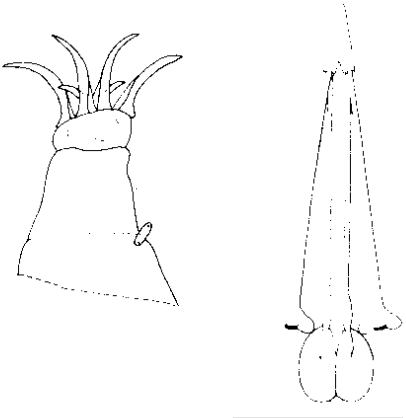
Kristensen RM. 1987. Generic revision of the Echiniscidae (Heterotardigrada), with a discussion of the origin of the family. pp. 261-335 in Bertolani R (ed). Biology of Tardigrades: Selected symposia and monographs.
Ramazzotti G, Maucci W. 1983. Il phylum Tardigrada(III edizione riveduta e aggiornata). English translation by C. W. Beasley, 1995. Memorie dell’ Istituto Italiano di Idrobiologia 41: 1-1012.
Thulin G. 1928. Über die Phylogenie und das System der Tardigraden. Hereditas. 11: 207–266. https://doi.org/10.1111/j.1601-5223.1928.tb02488.x
